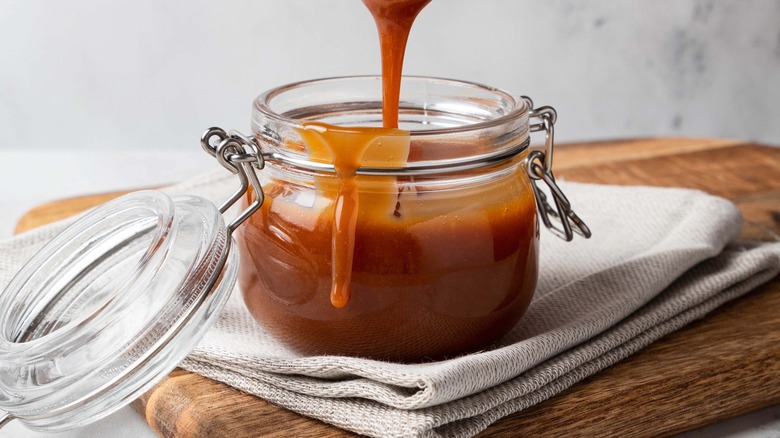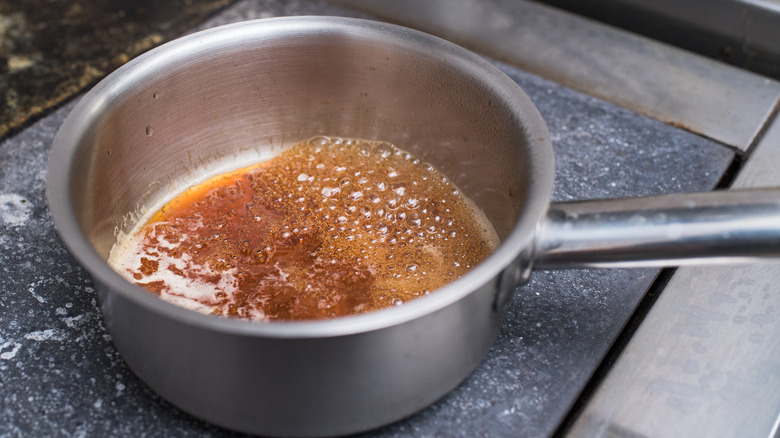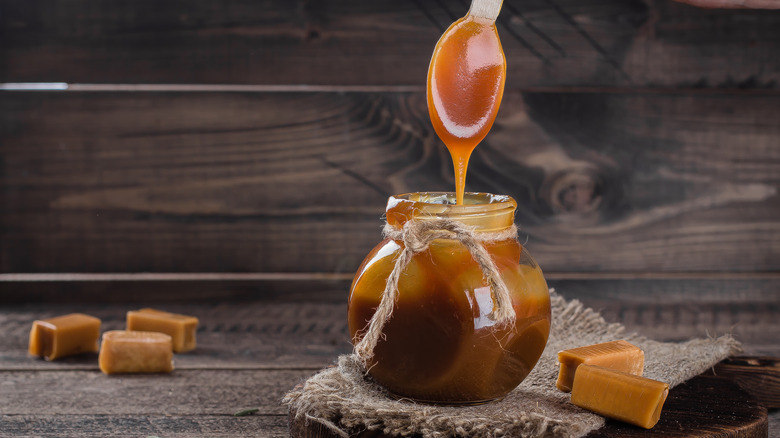What's The Difference Between Wet And Dry Caramel?
Caramel can be a confusing ingredient. Not just because it takes on so many forms as candy, dip, glaze, and filling, but also because caramel isn't just thought of as an ingredient but a flavor. It's similar to the way we describe whiskey, toffee, and dulce de leche. It also shows up in savory foods. Caramelized onions are a beloved sandwich topping, and we often talk about the caramelized crust on a well-seared steak as well. Neither of these foods has anything to do with caramel though, and more to do with the chemical reaction that creates caramel.
Caramel, in its most basic form, is simply sugar that has been heated to 340 degrees Fahrenheit. At this heat, the sugars undergo a change known as pyrolysis, where they turn a deep brown color, and their flavors transform from simple sweetness to something more complex. This process is known as caramelization. It's the same thing that makes roasted potatoes and caramelized onions so delicious, but it is also the defining reaction that creates caramel.
Achieving this state of candied bliss is more than just a matter of applying heat to sugar, though. Lots of things can — and often do — go wrong when making caramel. The two easiest ways to produce caramel are known as dry and wet caramel, but both require their own specialized knowledge to make correctly.
Dry caramel
Dry caramel is simply sugar that has been heated to form caramel. That's it — there's no butter, milk, cream, or even added water to this form of caramel. It can be an appealing option because it's so simple, but that simplicity hides the true challenge of making a dry caramel. It's actually more difficult to make than wet caramel (which includes sugar and water) because it burns so much more easily. It cooks faster, but this means that dry caramel doesn't have an opportunity to develop as complex a flavor as wet caramel because it is more likely to burn. Wet caramel includes water, which will keep the temperature even and stave off burning, giving it more time to develop deeper complexity.
Caramel is notorious for crystallization as well. The best way to avoid this is to avoid stirring the caramel as it cooks, but this can also increase the chances of burning. If too much of the heat is concentrated on the bottom layer of the pan, the sugars at that level will burn before the others caramelize properly.
To avoid this while making dry caramel, it's best to use a wide and shallow pan. This will help distribute the heat evenly, and you can then brush over the surface of the sugar gently with a rubber spatula to help even out the cooking.
Wet caramel
Wet caramel is made by heating a mixture of sugar and water. This helps by dissolving the sugar before it is heated. This distributes the heat more evenly and prevents burning.
The main challenge with wet caramel is having the patience to stand over without stirring the pot. Once the water and sugar mixture starts to boil it becomes risky to stir. Stirring the pot will cause water to splash onto the sides of the pot and evaporate. If too much water cooks off, the sugar will revert back to its crystallized structure and make your caramel grainy.
Wet caramel also takes longer to cook than dry caramel, so it takes more patience for the sugar to develop its flavor. Thankfully, wet caramel develops a more complex flavor than the dry version and is less likely to burn or turn bitter. This makes it well worth the wait.
No matter which method of caramel you choose to master and make at home, you certainly can't go wrong with this delicious confection.


